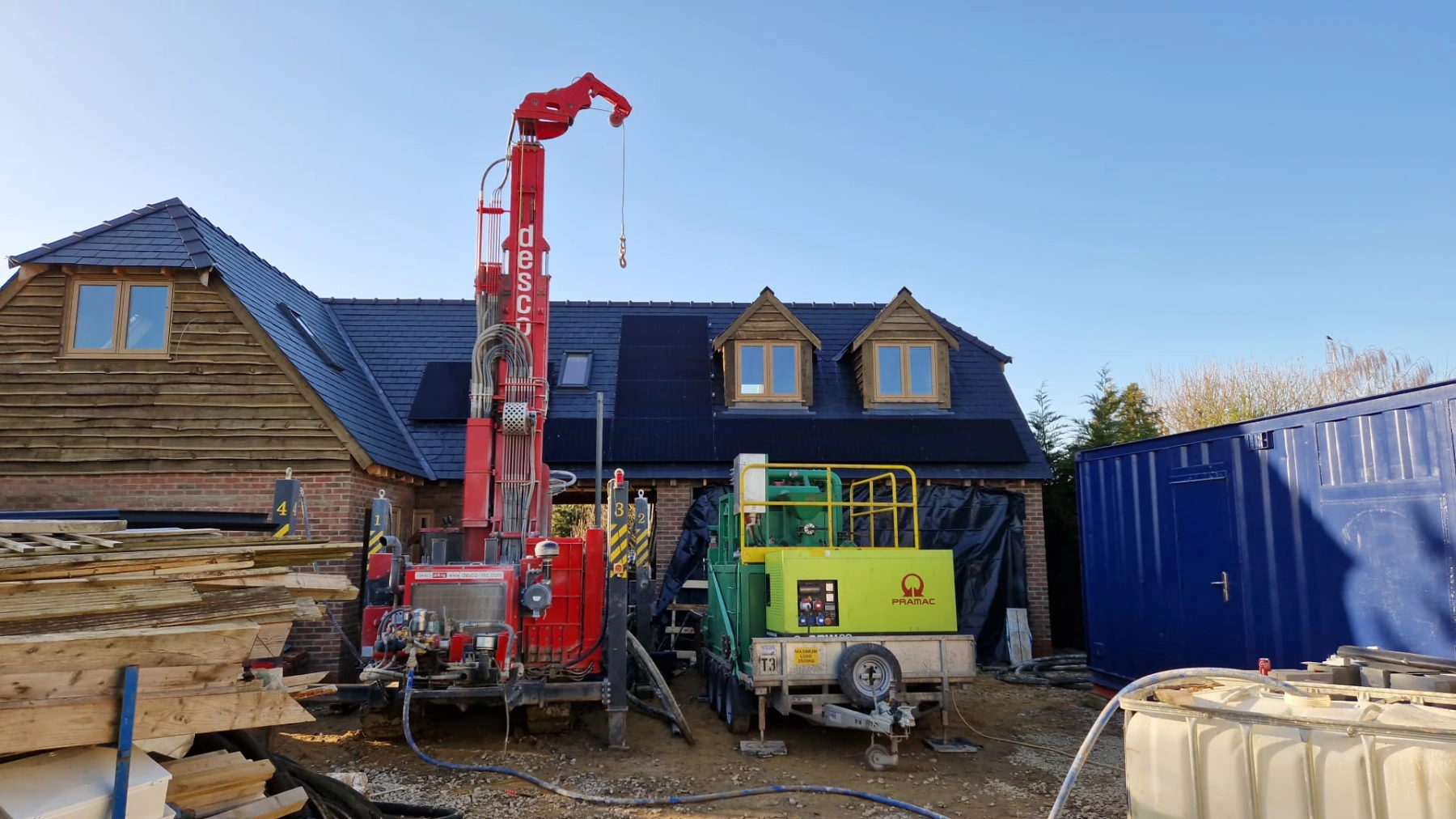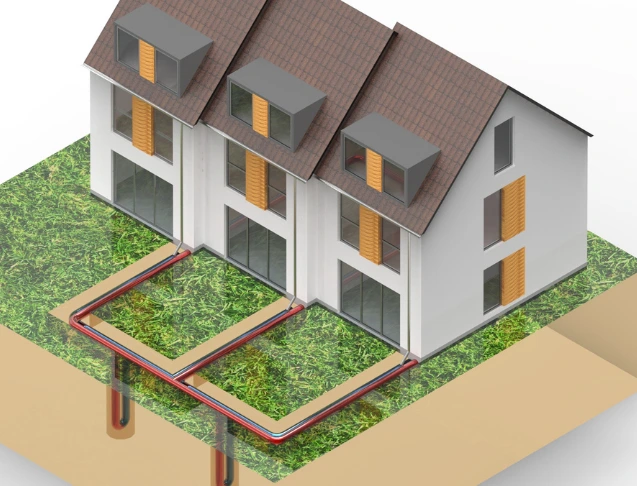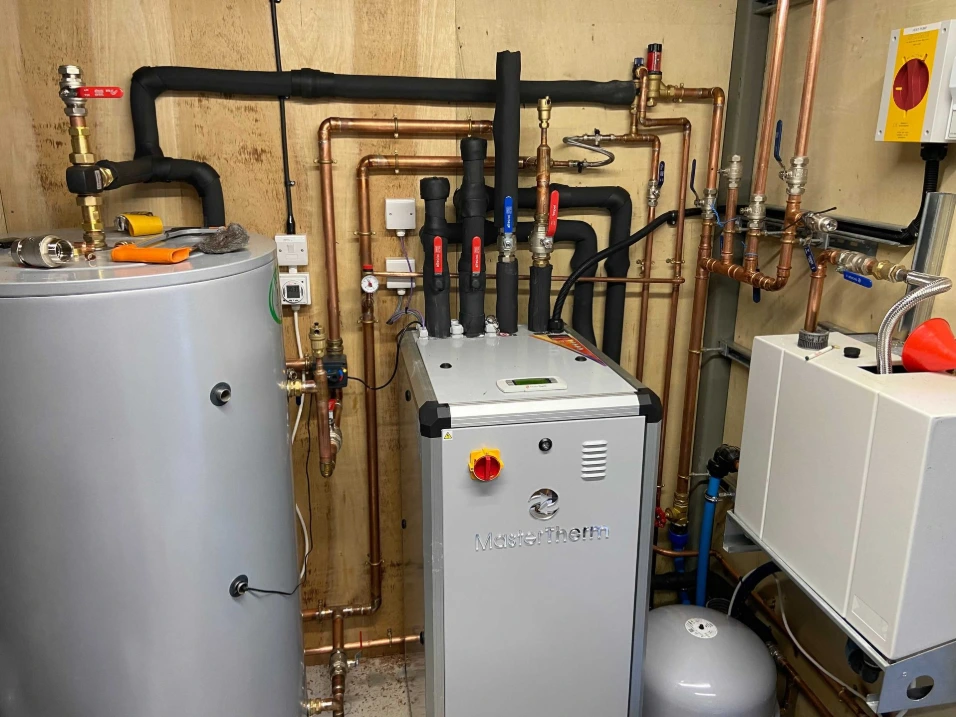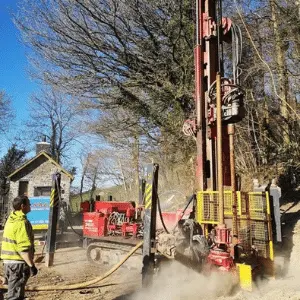Ground Source Heat Pumps
The most efficient heat pump technology available. Harness stable underground temperatures for year-round heating, cooling, and hot water with up to 500% efficiency.

Ground Source Heat Pumps
The most efficient heat pump technology available. Harness stable underground temperatures for year-round heating, cooling, and hot water with up to 500% efficiency.

Why Choose Ground Source?
The premium choice for maximum efficiency and longevity
Highest Efficiency
4-5kW of heat for every 1kW of electricity. The most efficient heating system available.
Heating & Cooling
Provides both active and passive cooling in summer. Year-round climate control.
No Visible Units
All equipment hidden underground or inside. Maintains your home's appearance.
Silent Operation
No outdoor fan means virtually silent operation. Perfect for noise-sensitive areas.
25+ Year Lifespan
Ground loops last 100+ years. Heat pump units last 25+ years with minimal maintenance.
£7,500 BUS Grant
Eligible for the Boiler Upgrade Scheme. We handle all the paperwork for you.
Why Choose Ground Source?
The premium choice for maximum efficiency and longevity
Highest Efficiency
4-5kW of heat for every 1kW of electricity. The most efficient heating system available.
Heating & Cooling
Provides both active and passive cooling in summer. Year-round climate control.
No Visible Units
All equipment hidden underground or inside. Maintains your home's appearance.
Silent Operation
No outdoor fan means virtually silent operation. Perfect for noise-sensitive areas.
25+ Year Lifespan
Ground loops last 100+ years. Heat pump units last 25+ years with minimal maintenance.
£7,500 BUS Grant
Eligible for the Boiler Upgrade Scheme. We handle all the paperwork for you.

How Ground Source Heat Pumps Work
Ground source heat pumps extract heat from the ground via buried pipes called ground loops. The ground stays at a constant 10-12°C year-round, providing a stable heat source even in the coldest winter.
Fluid circulates through buried pipes, absorbing warmth from the ground
The compressor raises the temperature to usable levels for heating
Warm water flows to radiators, underfloor heating, or hot water cylinder

How Ground Source Heat Pumps Work
Ground source heat pumps extract heat from the ground via buried pipes called ground loops. The ground stays at a constant 10-12°C year-round, providing a stable heat source even in the coldest winter.
Fluid circulates through buried pipes, absorbing warmth from the ground
The compressor raises the temperature to usable levels for heating
Warm water flows to radiators, underfloor heating, or hot water cylinder
Ground Loop Options
Choose the best solution for your property
Boreholes (Vertical)
Drilled 50-200m deep. Ideal for properties with limited garden space. Our in-house drilling team ensures quality.
Horizontal Loops
Buried 1-2m deep in trenches. Requires larger garden area but lower installation cost than boreholes.
Slinky Coils
Coiled pipes in trenches maximise heat extraction. Good balance of efficiency and space requirements.
Ground Loop Options
Choose the best solution for your property
Boreholes (Vertical)
Drilled 50-200m deep. Ideal for properties with limited garden space. Our in-house drilling team ensures quality.
Horizontal Loops
Buried 1-2m deep in trenches. Requires larger garden area but lower installation cost than boreholes.
Slinky Coils
Coiled pipes in trenches maximise heat extraction. Good balance of efficiency and space requirements.
Is a Ground Source Heat Pump Right for My House?
Ground source is ideal if you're seeking the highest performance, maximum efficiency and longest lifespan. Consider these factors:

Is a Ground Source Heat Pump Right for My House?
Ground source is ideal if you're seeking the highest performance, maximum efficiency and longest lifespan. Consider these factors:

Ground Source vs Air Source
Which heat pump is right for you?
| Feature | Ground Source | Air Source |
|---|---|---|
| Efficiency (COP) | 4-5 ⭐ | 3-4 |
| System Lifespan | 25+ years ⭐ | 15-20 years |
| Cooling Capability | Active & Passive ⭐ | Active Only |
| Noise Level | Silent ⭐ | Low (outdoor fan) |
| Visible Equipment | None ⭐ | Outdoor unit |
| Installation Cost | Higher | Lower ⭐ |
| Land Required | Garden/drilling access | Minimal ⭐ |
| BUS Grant | £7,500 ✓ | £7,500 ✓ |
Ground Source vs Air Source
Which heat pump is right for you?
| Feature | Ground Source | Air Source |
|---|---|---|
| Efficiency (COP) | 4-5 ⭐ | 3-4 |
| System Lifespan | 25+ years ⭐ | 15-20 years |
| Cooling Capability | Active & Passive ⭐ | Active Only |
| Noise Level | Silent ⭐ | Low (outdoor fan) |
| Visible Equipment | None ⭐ | Outdoor unit |
| Installation Cost | Higher | Lower ⭐ |
| Land Required | Garden/drilling access | Minimal ⭐ |
| BUS Grant | £7,500 ✓ | £7,500 ✓ |
Claim £7,500 with the Boiler Upgrade Scheme
If you own your home and are replacing a gas or oil boiler, you may qualify for £7,500 in government funding towards your ground source heat pump installation. We handle all the paperwork for you.
Claim £7,500 with the Boiler Upgrade Scheme
If you own your home and are replacing a gas or oil boiler, you may qualify for £7,500 in government funding towards your ground source heat pump installation. We handle all the paperwork for you.
Frequently Asked Questions
Everything you need to know about ground source heat pumps
Ground source heat pumps are the most efficient heating system available, providing 4-5kW of heat for every 1kW of electricity used (400-500% efficiency). This is significantly higher than air source heat pumps because the ground maintains a stable temperature of 10-12°C year-round, regardless of weather conditions.
Ground source heat pump units typically last 25+ years with minimal maintenance—longer than air source units. The ground loops themselves can last over 100 years, making GSHP an excellent long-term investment. This extended lifespan often offsets the higher initial installation cost.
You may qualify for the £7,500 Boiler Upgrade Scheme grant if you own your home in England or Wales, are replacing a gas or oil boiler, and have a valid EPC certificate. Ground source heat pumps are fully eligible for this government funding. We handle all the paperwork for you.
Boreholes (vertical) are drilled 50-200m deep and are ideal for properties with limited garden space. Horizontal loops are buried 1-2m deep in trenches and require more land but have lower installation costs. Our in-house drilling team can advise on the best option for your property. Both methods provide excellent efficiency.
Yes! Ground source heat pumps can provide both active and passive cooling. Passive cooling is particularly efficient—it circulates cool ground water through your underfloor heating or fan coils without running the compressor, using minimal electricity. This makes GSHP ideal for year-round climate control.
For boreholes, you only need enough space for the drilling rig to access (typically a driveway or small area). For horizontal loops, you'll need approximately 2-3 times the floor area of your home. Slinky coils can reduce the land required. We'll assess your property and recommend the best solution.
No—ground source heat pumps are virtually silent. Unlike air source heat pumps, there's no outdoor fan unit. The heat pump sits inside your home (usually in a plant room or utility area) and operates at similar noise levels to a refrigerator. This makes GSHP ideal for noise-sensitive locations.
A typical ground source heat pump installation costs £18,000-£35,000 depending on property size and ground loop type. With the £7,500 BUS grant, this reduces to £10,500-£27,500. While higher than air source, the greater efficiency and longer lifespan often make GSHP more cost-effective over time. Use our free estimate calculator for an accurate quote.
Yes! Thermal Earth has an in-house borehole drilling team with over 20 years of experience. This means we control the entire installation process from design to completion, ensuring quality at every stage. We don't subcontract drilling, so you deal with one company throughout your project.
Ground source offers higher efficiency (4-5 COP vs 3-4), longer lifespan (25+ years vs 15-20), silent operation, passive cooling, and no visible outdoor unit. However, it has higher upfront costs and requires garden access for installation. Air source is often better for smaller budgets or properties without land. Both qualify for the £7,500 BUS grant.
Frequently Asked Questions
Everything you need to know about ground source heat pumps
Ground source heat pumps are the most efficient heating system available, providing 4-5kW of heat for every 1kW of electricity used (400-500% efficiency). This is significantly higher than air source heat pumps because the ground maintains a stable temperature of 10-12°C year-round, regardless of weather conditions.
Ground source heat pump units typically last 25+ years with minimal maintenance—longer than air source units. The ground loops themselves can last over 100 years, making GSHP an excellent long-term investment. This extended lifespan often offsets the higher initial installation cost.
You may qualify for the £7,500 Boiler Upgrade Scheme grant if you own your home in England or Wales, are replacing a gas or oil boiler, and have a valid EPC certificate. Ground source heat pumps are fully eligible for this government funding. We handle all the paperwork for you.
Boreholes (vertical) are drilled 50-200m deep and are ideal for properties with limited garden space. Horizontal loops are buried 1-2m deep in trenches and require more land but have lower installation costs. Our in-house drilling team can advise on the best option for your property. Both methods provide excellent efficiency.
Yes! Ground source heat pumps can provide both active and passive cooling. Passive cooling is particularly efficient—it circulates cool ground water through your underfloor heating or fan coils without running the compressor, using minimal electricity. This makes GSHP ideal for year-round climate control.
For boreholes, you only need enough space for the drilling rig to access (typically a driveway or small area). For horizontal loops, you'll need approximately 2-3 times the floor area of your home. Slinky coils can reduce the land required. We'll assess your property and recommend the best solution.
No—ground source heat pumps are virtually silent. Unlike air source heat pumps, there's no outdoor fan unit. The heat pump sits inside your home (usually in a plant room or utility area) and operates at similar noise levels to a refrigerator. This makes GSHP ideal for noise-sensitive locations.
A typical ground source heat pump installation costs £18,000-£35,000 depending on property size and ground loop type. With the £7,500 BUS grant, this reduces to £10,500-£27,500. While higher than air source, the greater efficiency and longer lifespan often make GSHP more cost-effective over time. Use our free estimate calculator for an accurate quote.
Yes! Thermal Earth has an in-house borehole drilling team with over 20 years of experience. This means we control the entire installation process from design to completion, ensuring quality at every stage. We don't subcontract drilling, so you deal with one company throughout your project.
Ground source offers higher efficiency (4-5 COP vs 3-4), longer lifespan (25+ years vs 15-20), silent operation, passive cooling, and no visible outdoor unit. However, it has higher upfront costs and requires garden access for installation. Air source is often better for smaller budgets or properties without land. Both qualify for the £7,500 BUS grant.
Ground Source Heat Pump Installation Guide
Learn more about the process of installing a GSHP system.


Ready to Switch to Ground Source?
Get your free estimate in 5 minutes or speak to our team about the best solution for your property.
Ready to Switch to Ground Source?
Get your free estimate in 5 minutes or speak to our team about the best solution for your property.